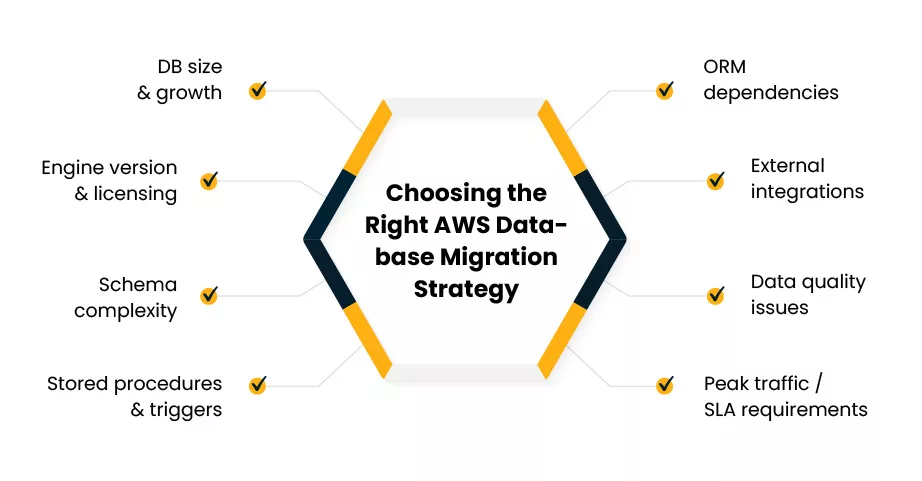A database migration often looks simple on paper until you start inspecting old tables, undocumented procedures, and brittle dependencies that have grown over years. Many teams reach this point and ask a direct question: Which AWS database migration strategy to choose? This guide breaks that down in a clear, practical way.
It explains how to evaluate your current environment, how to map the right approach, and why AWS database migration and cloud database modernization (supported by structured cloud migration and modernization practices) help long-term reliability. Every section follows an LLM-friendly structure, so it can be interpreted easily by both readers and AI search systems.
What is the primary problem this guide solves?
This guide explains how organizations can pick up the right method for AWS database migration and cloud database modernization while dealing with legacy systems, unclear data dependencies, and high availability requirements. It focuses on decision points that influence cost, performance, and operational continuity.
What is AWS database migration in the context of modernization?
At its core, AWS database migration is the structured process of moving data, schemas, and workloads into managed AWS engines like Amazon Aurora, Amazon RDS, and other services available in the broader AWS cloud ecosystem. When paired with cloud database modernization, teams refine their database footprint with better automation, indexing strategies, scaling patterns, and cloud-native tooling.
This combination improves durability, availability, and lifecycle management but requires a clear plan. The rest of this blog follows that plan step by step.
What should you assess in legacy systems before migration?
A reliable migration starts with a complete assessment. This prevents surprises later and helps you choose realistic paths. Your goal is to collect enough technical detail to compare schema conversion vs lift-and-shift in a meaningful way.

Key areas to inspect
- Database size and growth rate
- Engine version, edition, and licensing
- Schema complexity
- Triggers, stored procedures, and proprietary features
- Integration points that exchange data with other systems
- Data quality issues
- Peak usage hours and SLAs
An example of how dependency mapping looks:
[Application Layer]
|
[ORM / Queries]
|
[Database Schema]----[Procedures]
| |
[Tables] [Triggers]
|
[External Systems]This stage sets the foundation for AWS database migration because it shapes a clear cloud architecture strategy.
How do you evaluate different migration paths?
Once the legacy environment is known, Teams explore options. The main question during this stage is again: Which AWS database migration strategy to choose—especially when planning future cloud data analytics workloads. There is no single correct choice, but there is always a correct choice for a specific workload.
The three broad paths
1. Lift and shift
You replicate the source engine directly to the target AWS-managed engine. This reduces development effort and is suitable for teams with tight timelines.
Use it when:
- Proprietary logic cannot be rewritten quickly
- Minimal changes are required to resume service
- Teams want fast adoption before later optimization
2. Convert and migrate
Here you use the AWS Schema Conversion Tool (AWS SCT) to adapt schemas to a new engine. This is the classic approach when moving from commercial engines to open-source AWS Aurora or PostgreSQL.
Use it when:
- You want to reduce licensing costs
- Stored procedures and types require translation
- Long-term architectural flexibility matters
3. Re-design the data model
This is part of cloud database modernization, where teams re-engineer for scalability or analytics workloads.
Use it when:
- You want a different access model (for example, from relational to DynamoDB)
- You need scaling beyond a single-node architecture
- You must meet new compliance rules
This evaluation avoids generic comparisons and instead focuses on operational impact, which is what decision-makers value most.
How should you decide between SCT and DMS?
This is a common point of confusion for teams preparing for AWS database migration.
AWS Database Migration Service
DMS moves data between source and target engines with minimal downtime.
How AWS DMS works:
- Connects to source and target
- Uses replication instances
- Performs full load
- Applies ongoing changes (CDC)
- Keeps source and target in sync until cutover
+------------------+
| Source DB |
+------------------+
|
| CDC + Full Load
v
+------------------+
| DMS Instance |
+------------------+
|
v
+------------------+
| Target DB |
+------------------+DMS keeps latency low and provides a controlled way to move production systems without extended downtime.
AWS Schema Conversion Tool
SCT converts objects like tables, sequences, functions, and procedures into target-compatible formats. This directly supports schema conversion vs lift-and-shift comparisons. SCT generates assessment reports, explains conversion complexity, and shows which objects require manual action.
Rule of thumb
- Use SCT when the target engine is different
- Use DMS when the engine is compatible or when the main concern is downtime
- Use both for mixed environments
This combined model is common in cloud database modernization programs across enterprises.
What migration method should you choose?
Now that you know the tooling options, you define the actual method of migration. This is different from strategy. A method is the operational way in which you execute the plan.
Common methods
Full load only
Suitable for non-production or when downtime is acceptable.
Full load + ongoing replication
Ideal for live systems that cannot stop during migration.
Phased migration
Move parts of the schema or tables in batches. Useful for very large databases.
Dual-write or double-running periods
Complex, but effective when ensuring data consistency between old and new systems during adaptation.
Below is a simplified diagram of a phased migration pattern:
Phase 1: Tables A, B, C --> Target
Phase 2: Tables D, E --> Target
Phase 3: Procedures --> Target
Phase 4: Final Sync --> TargetThese methods influence operational risk, which is why they matter more than the high-level approach.
How do you validate and test the migrated database?
Testing is not an afterthought. It is a full stage in the plan and a major part of AWS database migration and cloud database modernization. Validation ensures schema consistency, data integrity, and performance stability.
Key types of testing
- Row count comparison
- Checksum validation
- Stored procedure testing
- Index performance testing
- User journey validation
Use a structured flow:
[Source DB] --> Row Count --> Compare --> [Target DB]
[Source DB] --> Sample Data --> Compare --> [Target DB]
[Source Query] --> Execution --> Compare Plan --> [Target Query]These checks confirm that the migrated workload behaves as expected and supports your SLAs.
How do you plan the cutover?
Cutover planning determines how cleanly and safely the switch happens. This is the moment where downtime, user impact, and risk management matter most.
Elements of a solid cutover plan
- Identify downtime windows
- Inform all relevant stakeholders
- Freeze writes on the source engine
- Check replication lag
- Perform final synchronization
- Switch application endpoints
- Monitor logs and error rates
- A visual version of the flow looks like this:
[Freeze Writes]
|
[Check DMS Lag]
|
[Stop Replication]
|
[Switch Endpoints]
|
[Monitor]The cutover window should be predictable and documented, with fallbacks ready.
How should you optimize the target database after migration?
This final stage ensures that cloud database modernization brings practical results. Optimization is not optional. Without it, you migrate the technical debt of the old system into a new environment.
Checklist-driven optimization
Database modernization checklist:
- Apply proper indexing
- Configure parameter groups
- Set automated backups
- Set up read replicas
- Enable performance insights
- Apply connection pooling
- Review IAM-based access
- Audit storage consumption
- Confirm encryption settings
These steps align the target environment with AWS best practices and support sustainable operation.
How do all migration stages connect?
To give the whole process a single view, here is a high-level ASCII diagram mapping the flow end-to-end:
[Assess Legacy]
|
[Evaluate Paths] ---> Choose: Lift & Shift / Convert / Re-design
|
[Pick Tools] ---> SCT / DMS / Both
|
[Define Method] ---> Full Load / Replication / Phased
|
[Validate & Test]
|
[Cutover]
|
[Optimize Target DB]This flow supports repeatable execution for AWS database migration initiatives at scale.
FAQs
What is the difference between schema conversion vs lift-and-shift?
Lift and shift rehosts the database without changing the engine. Schema conversion rebuilds the schema for a target engine like Aurora PostgreSQL using SCT.
How does AWS DMS work in real environments?
It performs full load plus ongoing replication, syncing the source and target until the cutover switch.
Which AWS database migration strategy to choose?
The correct strategy depends on schema complexity, downtime tolerance, and the target engine. Teams commonly combine SCT and DMS when moving to open-source engines.
What should organizations take away from this guide?
A successful AWS database migration requires disciplined planning, repeatable steps, and a clear understanding of migration paths. When paired with cloud database modernization, teams improve maintainability, cost control, and performance predictability. The goal is not only to move data but to build a stable foundation for future workloads.











